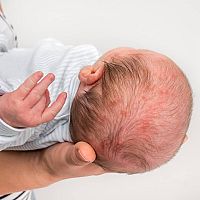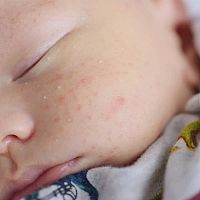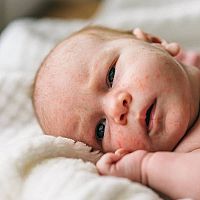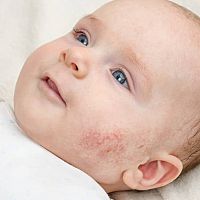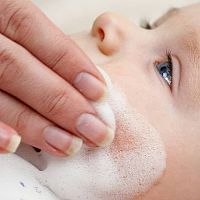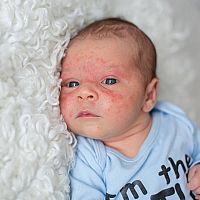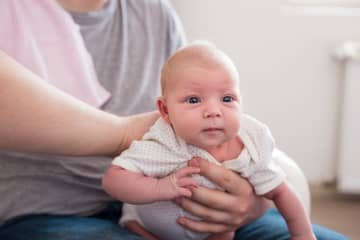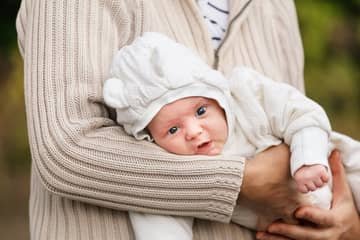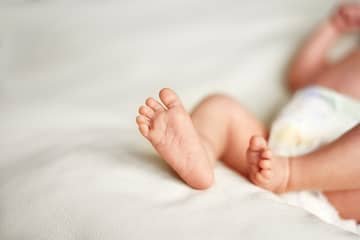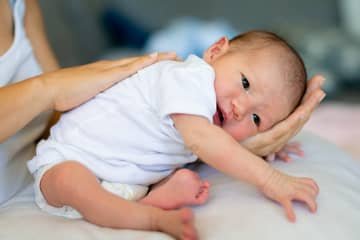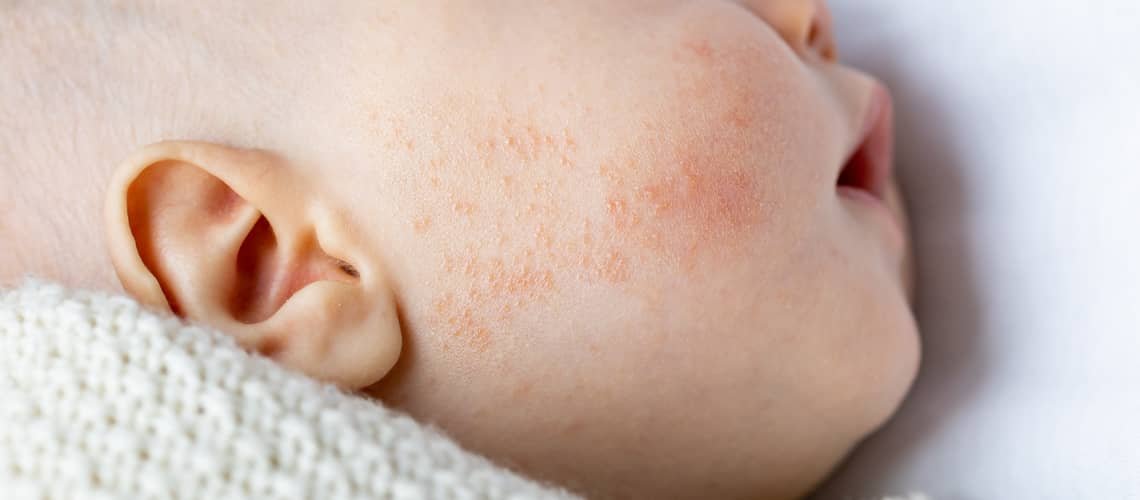
Newborn acne - red semolina rashes in a newborn and their treatment
Acne problems are more typical for the adolescent age or later in adulthood. However, the occurrence of newborn acne is typical for babies under 2 months of age and globally occurs in up to 20% of newborns between the 2nd and 4th week of birth. It is a transient skin disease that usually does not require any special diagnosis or treatment. Newborn acne usually goes away on its own. What does it mean if your baby has acne? What does newborn acne look like and what helps with newborn acne?
Taking care of the baby is a priority for parents, and even the smallest signs of complications can often worry them. An unsightly rash on the face in the form of newborn acne is one of the reasons. First of all, it is important to remember that it is only a temporary condition and baby acne will disappear on its own. Nevertheless, it is advisable to know what rashes on the face of a newborn look like, where they occur or why they actually occur.
What is newborn acne?
It is also known as baby acne or infant acne. It is a short-term - transient skin disease, which is manifested by the formation of pimples on the child's skin. Newborn acne most often appears on the baby's forehead, nose, cheeks or neck. However, newborn acne can spread to the chest or scalp. Red, whitish to gritty rashes (comedones) are formed. Most often, newborn acne occurs around the 2nd to 4th week, and it appears at most up to the age of 2 months after birth. In some newborns, it is already present at birth. Newborn acne usually disappears on its own within a few weeks.

Reasons for the occurrence of newborn acne
Why does newborn acne occur? The exact reason for acne in newborns is not clear. However, the most likely reason is the influence of hormones. Specifically, it concerns androgens, which the baby received from the mother before birth through the placenta. The body's reaction can manifest itself through the appearance of newborn acne. Clogged pores then turn into red rashes on the baby's face, which then tend to swell and turn into semolina rashes in children. At the same time, children's skin is very sensitive and reacts to the environment and everything it comes into contact with. The immune system thus reacts with increased sensitivity of the sebaceous glands, which can also contribute to the formation of acne in babies.
What does newborn acne look like?
If you want to identify whether it is really newborn acne in a particular case, age can also help, as baby acne is typical for children up to 2 months after birth. These are small and red rashes in children, bumps or pustules, which may have a reddened or purple surrounding. They are often filled with pus, just like adolescent acne. That is why it is customary to talk about semolina rashes in newborns.
And when will newborn acne disappear? Baby acne can appear suddenly, but it can also develop slowly. First, reddened small pimples may appear, which later disappear or become filled with pus. However, they usually disappear within a few weeks. If you suspect that it may be another skin disease in your baby, visit your pediatrician.
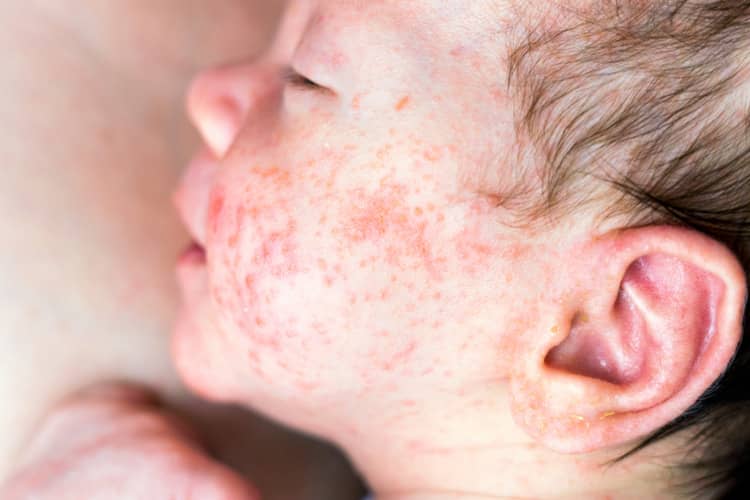
Locations of baby acne
Most often, newborn acne appears on different parts of the face:
- forehead,
- cheeks,
- nose,
- chin,
- neck
The worst thing is if there is newborn acne in the hair. It is easier to overlook it and you can irritate the skin when washing, which can lead to an increase in the inflammation of the pimples, which subsequently become redder. Acne can also appear on the baby's chest or back.
Newborn vs infant acne
Newborn acne and infant acne are seen as one and the same disease. Basically it's fine. In both cases, we can talk about identical symptoms and places of occurrence. The difference, however, is that newborn acne and its occurrence are typical for the first weeks after birth. It usually disappears by the 6th month. Infant acne usually occurs in babies between the ages of 2 and 12 months. The difference can also be black dots, which are more typical for infant acne and do not occur with newborn acne.
You can also confuse newborn acne with pimples, which do not appear on the face, but in skin folds. Also known are the so-called milia in children, which are slightly elevated whitish pimples that also disappear on their own. Rarely, acne can resemble an allergic reaction.
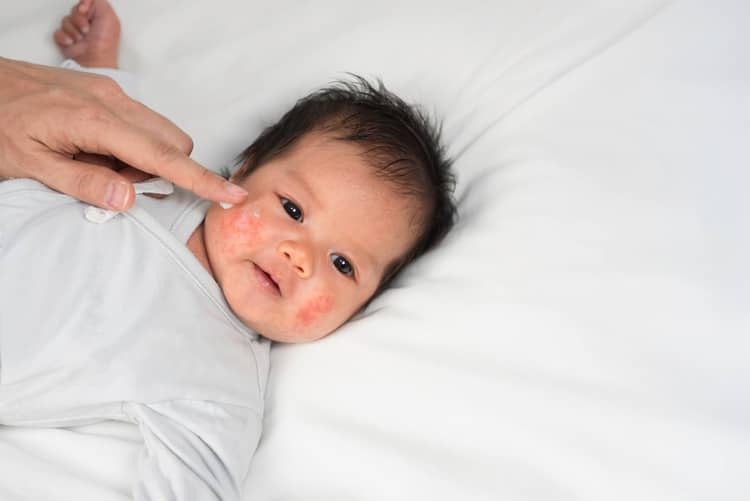
Newborn acne - treatment
In most cases, newborn acne does not need to be diagnosed or treated in any special way and will go away on its own. First of all, only the patience of the parents is needed. Unnecessary medical interventions can cause a deterioration in the quality of the baby's skin. Definitely do not squeeze or scratch acne. Do not use any lotions, creams or cleansing gels intended for adults on children's skin. Standard hygiene and bathing the baby is sufficient. If you want to help acne heal, we have some tips for you.
Black tea for acne
You can rub the skin affected by acne with a cooled decoction of black tea. Black tea has a soothing effect on the skin. A tea decoction made from rapeseed can also have a similar effect. Always wipe your face dry after rubbing with tea. For this purpose, do not use any other herbal tea mixtures, which can potentially cause an allergic reaction.
Breast milk for newborn acne
Rubbing acne-prone skin with breast milk has proven beneficial for some mothers. It is most suitable to rub the skin with breast milk at night, then the milk can work effectively. However, it is recommended to exclude spicy foods, strawberries or tomatoes or raw materials that can potentially cause allergies from the diet.
Sudo cream for newborn acne
This proven preparation is also suitable for soothing the sensitive skin of a baby. By rubbing newborn acne, you will speed up healing and at the same time the child will not have a tendency to scratch. Thanks to lanolin, the rate of pimple inflammation is also effectively reduced. Holt's cream for newborn acne, which is also recommended by pediatricians, is also very effective.
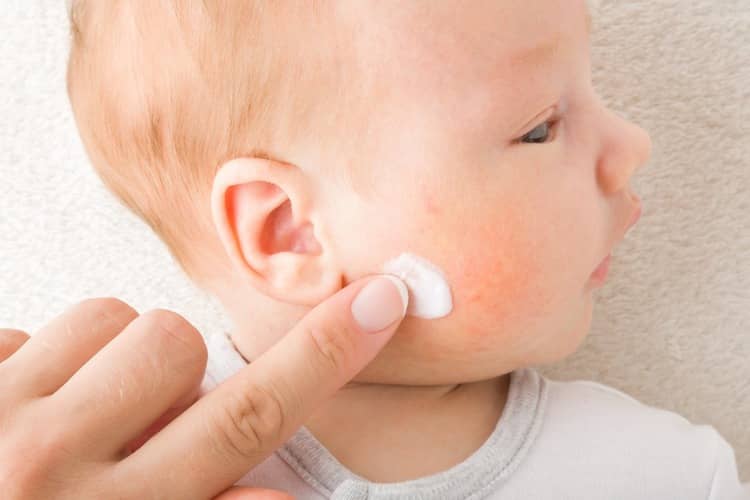
Rashes in a newborn - a visit to the doctor
Is the baby thrown away even after a few months? Do the pimples irritate the child, does he scratch them, is he dissatisfied, is the skin reddened or has discharge or swelling appeared around the pimples? In such a case, it is best to consult a doctor about treatment, who will recommend any special creams or medicines. See a doctor even if you suspect that it may be skin eczema or other purulent rashes.
Prevention against infant acne?
There is no effective prevention that would prevent the occurrence of newborn acne. Due to the fact that this temporary skin disease has a hormonal origin, it is not possible to prevent the appearance of acne in a baby by normal processes. The occurrence of newborn acne statistically occurs in 20% of newborns.
Experiences
According to mothers, newborn acne is unpleasant to look at, but with proper care it can disappear very quickly. According to them, nettle decoction, alcohol in combination with indulona (one in the morning, the other at night), a special cream from the pharmacy, but also Sudocrem are effective.
The most frequent questions - FAQ
Have you encountered newborn acne in your child? Do you suspect that your baby is experiencing this transient skin condition? We'd love for you to join the discussion. If you have experience with newborn baby acne, other parents will certainly appreciate your advice and recommendations. If you need advice, do not hesitate to write us a comment. We will be happy to help you.
When will baby acne go away?
What is newborn acne?
What helps with baby acne?
Is newborn acne caused by breast milk?
Does purchased infant milk cause acne?
Gallery
Pridať komentár

